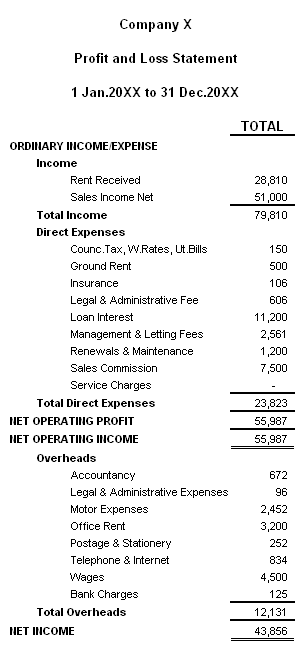Property Company Profit and Loss Statements
An analysis of the profitability of any investment property
is based on the operating profit it generates minus any overheads. Operating profit or net operating income is direct expenses incurred from generating income from an investment property minus that income. Overheads are expenses incurred in admininstrating an investment property irrespective of whether it generates any income or not.
Operating Profit
A property company can own more then one property. In our example below, Company X Ltd owns three properties. For the period 1 Jan.20XX to 31 Dec.20XX Company X Ltd recorded the following operating income and expenses for each property.

In terms of rental income the most profitable properties are 1 and 3 which generate $3,720 and $12,920 net operating income respectively. Note that they receive comparatively higher rental income with property 1 receiving $11,440 and property 3 receiving $16,120.
Since the rental income for property 2 was only $1,250 and this rental income has been consistently low for the previous years, it is deemed more profitable to sell the property for $51,000 for a net operating income of $39,347. Since this property changes hands this therefore reduces the property stock hold by the company to two properties.
Since these properties 1 and 3 are still part of the company's property stock it is expected that they will continue generate rental income for the next financial period. The comparatively minor expenses incurred by each property in relation to their rental income indicates that they are viable investments. However, the loan interest for the mortgage taken on property 1 should be reduced by a re-mortgage.
Overheads
Note that the above does not consider any overheads incurred by Company X for its investment properties. Overheads include such things as accountancy fees, motor expenses, office rent, wages and so forth which cannot be apportioned per property. Instead overheads are totalled and then deducted from total net operating income earned by the company from all its investment properties together.

In the above profit and loss statement Company X has incurred overheads amounting to $12,131 giving a net profit of $43,856. For the company to remain solvent it must ensure that the net operating income from the two remaining properties in its property stock exceeds its overheads. If all figures are kept constant for the next year then the company's net operating income exceeds its overheads by $4,510 so the Company X is gaining on its remaining property stock.

In order for the company to remain solvent its must ensure that the net income from its property stock remains either constant or increases.
Related Topics
Group Property Company Profit and Loss Statements
Group Property Company Balance Sheets
Group Company Property Stock Analysis
Property Company Balance Sheets
Property Stock Analysis
